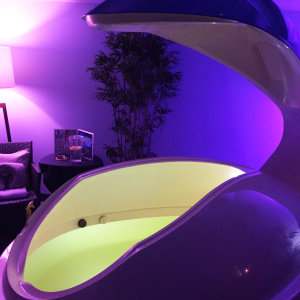Should You Try Flotation Therapy?
- Oct
- 09
- Posted by admin
- Posted in flotation therapy, Updates
 If Mitch Jordan’s new BMW had suffered a hit-and-run accident eight months ago, the venture capitalist owner near Pasadena, California, would have fumed. “I would have felt such resentment and anger toward whoever this person was,” imagines Jordan, 48, whose last name has been changed to protect his privacy.
If Mitch Jordan’s new BMW had suffered a hit-and-run accident eight months ago, the venture capitalist owner near Pasadena, California, would have fumed. “I would have felt such resentment and anger toward whoever this person was,” imagines Jordan, 48, whose last name has been changed to protect his privacy.
But when that very scenario happened recently, he only felt one emotion: appreciation for the couple who witnessed the event, captured it on camera and offered to act as witnesses for insurance claims. “There are some good people out there that cover your back,” Jordan says he realized. “And so rather than being upset, I found myself only focusing on gratitude.”
What accounts for Jordan’s newfound sense of calm in the face of chaos? He chalks it up to his near-weekly floats, or hour-long sessions which involve floating, naked, in an Epsom-salt infused tub in silence and darkness. While Jordan mainly uses the practice to de-stress and clear his mind, others float to spur creativity, accelerate meditation, enhance athletic performance and treat a wide range of physical and mental health conditions.
“I am very surprised it is not used frequently at conventional centers; it offers a treatment option for chronic pain, depression, anxiety and sleeping problems, [most of which] are treated with pharmaceutical products,” says Anette Kjellgren, a psychology professor at Karlstad University in Sweden who’s researched the topic for more than 15 years. “Here is a drug-free treatment that works. Why not use it?”
More people are. While the practice – called float therapy or flotation therapy – has been around since the 1970s, its popularity has escalated in recent years, says Jim Hefner, founder of Just Float, the center Jordan visits in Pasadena. The demand there is a case in point: Since opening its doors less than one year ago, “well over 10,000” floats have been completed at Just Float. With 11 float cabins, it’s the largest float center in the world.
It’s easy for Jordan, who first tried floating after a Facebook ad intrigued him, to see why. While he also meditates, hikes and receives acupuncture regularly, nothing compares to floating, he says. “Where [else] can you really go where there’s complete silence, where there’s no external stimulation?” Jordan asks. “The only place that comes close to that is the shower.”
How Does It Work?
When new float clients enter New York City’s Aspire Center for Health and Wellness, a physical therapy clinic with two float tanks, they’re led into a candle-lit float room with a bathroom, shower and the float tank center-stage. Clients are asked to shower away any lotions and body oils, protect any open wounds with Vaseline, pop in ear plugs and lower themselves into the lukewarm tub of saltwater. Whenever they’re ready, they can push a button to turn off the lights inside the tank and another one to lower the lid.
Once they’re enclosed in complete silence, darkness and weightlessness, floaters are asked to do something they’re rarely, if ever, asked to do in their daily lives: “Just be,” instructs Daniella Goodish, the center’s director of operations and facilities who assures clients that there’s no right or wrong way to float. After all, by removing as much sensory input as possible – even the water is set at a specific “skin-receptor neutral” temperature so that floaters can’t feel where their skin ends and the water begins – there’s not much to do other than, well, just be.
“This is a time to just not think about anything and just allow myself to be in the body and have this experience, and it was very transformative,” Jordan says of his first float. “I found a deep, deep sense of peace.” His “most profound” float brought to life a detailed childhood scene – complete with the placement of a rock and the scent of his neighborhood – he hadn’t thought of in years. “I think there is something to this that really activates and transcends memories,” Jordan says.
All such experiences and more are normal, Hefner says. He’s seen people emerge so overwhelmed with feelings of well-being, they cry and hug Just Float’s staff. Others are screenwriters who burst out of the center with new inspiration for their scripts. Smokers may quit once and for all, alcoholics may turn a corner toward sobriety and people in unfulfilling careers or unhappy relationships may find the courage to make a life change. Some, still, just fall asleep.
No matter how profound or not their experience, one generality applies to most floaters: “Floating,” Hefner says, “tends to make people feel pretty damn awesome.”
What Does the Research Say?
While there’s much more to be done, researchers have made some promising links between floating and relief from various maladies, namely anxiety, depression and sleeping problems. In one study published this year, for instance, Kjellgren and a colleague found that people with generalized anxiety disorder who floated for 12 45-minute sessions over the course of seven weeks significantly reduced their anxiety symptoms while also improving their sleep and mood. Six months later, the participants were still reaping almost all of the benefits. “We expected the effects to be more of a relief in the moment, but instead, it turned out to be a cure for many people,” Kjellgren says.
Other studies have documented the positive effects of flotation therapy – often called restricted environmental stimulation in research – on fibromyalgia, exercise recovery, smoking cessation, eating disorders, substance abuse, premenstrual syndrome and even for autism, though in many cases it works best in tandem with other therapies and typically after about 12 floats, Kjellgren says.
Hefner explains flotation therapy’s promise by describing it as a fast-track to meditation, which has well-established and far-reaching benefits to body and mind. “We have the vehicle for practicing meditation in its best form,” he says. At the Laureate Institute for Brain Research in Tulsa, Oklahoma, a research team led by clinical neuropsychologist Justin Feinstein is studying just how flotation might work at the neurological level to help patients tap into their body’s “brain maps” and, in turn, stave off or treat certain diseases.
Meantime, it’s important to remember that there are other, proven treatments for mental health conditions, and praising flotation too soon could deter people from seeking evidence-based help, says Dr. Harry Croft, a psychiatrist at Clinical Trials of Texas who has evaluated over 8,000 veterans, many with post-traumatic stress disorder. Floating, which insurance doesn’t typically cover, isn’t cheap either: An hourlong session can cost between $50 and $100, and most centers encourage multiple, if not regular, floats in order to reap the benefits. And, while the practice is relatively risk-free, save getting saltwater in your eyes or feeling claustrophobic, people with certain conditions including psychosis and untreated epilepsy should not float, Kjellgren adds.
“If people are willing to try it, with the caveat that it may work, it may not work … and you can afford it,” Croft says, “go for it.”
Search Dr.Croft.com
Dr. Harry Croft’s PTSD Blog
Recent Comments
Archives
- August 2022
- December 2018
- April 2017
- March 2017
- February 2017
- January 2017
- October 2016
- January 2015
- October 2014
- April 2013
Categories
- Abuse
- Alzheimer's
- bipolar
- depression
- Eating Disorder
- flotation therapy
- Media
- PTSD
- Research
- Uncategorized
- Updates






